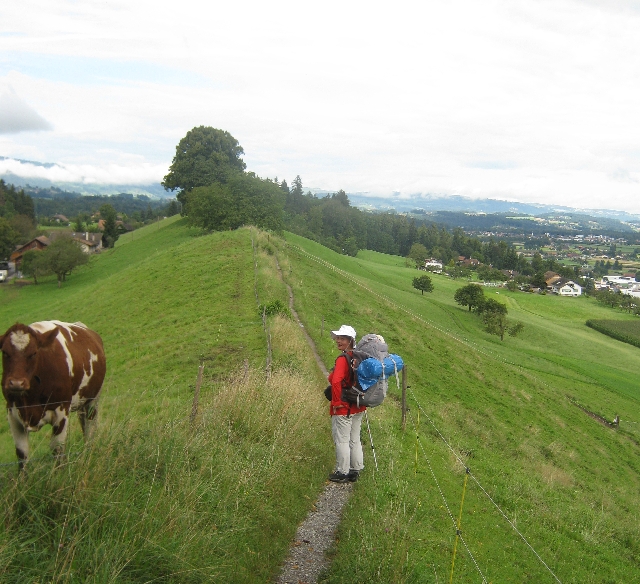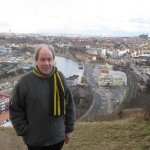
After a night punctuated by further thunder, lightning and rain, we awoke to grey skies the next morning and heard the pitter-patter of rain falling once more whilst we were eating breakfast. But just as we were resigning ourselves to a wet day, blue sky began to appear above the hill behind where we were staying. Our host assured us that where the blue sky was appearing, was the direction from which the weather always came. Fortunately, her forecast proved true and we enjoyed a dry and increasingly sunny day.
We first walked three kilometres back to the main Jacobsweg at Gwatteg, passing along this interesting path which traverses a low ridge with wonderful views on either side.

The Jacobsweg across Switzerland is waymarked as long-distance footpath 4 as here on this signpost at Gwattegg. Route 4 in the direction to Santiago is additionally marked with a blue border and golden scallop shell. Route 4 in the opposite direction just has the plain green background.

Around lunchtime, we reached the village of Amsoldingen with this delightful pre-Romanesque Church.

Since the Reformation, it has belonged to the Swiss Reformed Church and at some point, the interior must have been re-ordered with the font made the central focus.

However, one delightful pre-reformation fresco has been preserved.
In the afternoon, we walked on towards the small town of Wattenwil. Sybille had earlier phoned ahead to a farm outside Wattenwil, and booked for us to schlaf im Stroh/sleep on straw, a uniquely Swiss form of accommodation on farms. Click on the link for an explanation in English.
Fortunately, as we reached the outskirts of Wattenwil, there was a poster advertising the self-same farm, Erlebnis Hofmatt, with a map of how to reach it from the centre of the town. But the poster also said that if your legs were too tired, and mine by then certainly were 🙁 , then all you needed to do was to walk to the Church in the town centre and then phone the farmer who would drive down and collect you. We took the easy option 🙂
Whilst there were two German families staying in other accommodation at the farm, we had the upstairs loft with its long bed of straw to ourselves. Herr Künzi laid out two blankets on the straw and gave us pillows and then all we had to do was spread our respective sleeping bags on the blankets. Showers and toilets were provided and we had a most comfortable night’s sleep and an excellent breakfast the following morning.


Once more there was rain overnight but it had all but stopped raining by the time we climbed the hill from the farm next morning, making our way to rejoin the Jakobsweg. This was the view behind us with Erlebnis Hofmatt, the building in the bottom right of the photograph.

Whilst this was our final view of the Thunersee.

Just before midday, as you can see, we reached the Church at Riggisberg. It being Sunday 10th August, the last of the tidying up following the morning service was taking place. Here, as with nearly every Swiss Reformed Church that we visited, there were toilets open and available for use. Most Roman Catholic Churches were open but rarely had toilets. This raised a question in my mind. Does a Protestant sermon take longer than the time it takes to celebrate a Roman Catholic mass, hence the need for toilet facilities for Protestants? 🙂 My other suggestion, which Sybille declared, won the prize for the worst joke of the week, was that clearly the Swiss Reformed Church were ‘flush’ with money!

From Riggisberg, we climbed further to reach neighbouring Rüeggisberg. We were both amused to find that the residential street leading to the centre of the small town, was actually called ‘Jakobsweg‘ 🙂 What this photograph also reveals is something that was to catch us out later that afternoon. Not every waymark on the Jakobsweg has the route 4 sign on it. Some intervening signs, as here, just say ‘Wanderweg‘. The trouble is, other waymarked routes are also just signposted ‘Wanderweg‘, meaning it is possible to end up on the wrong ‘Wanderweg‘ 🙁
In Rüeggisberg are these remains of what was once a very extensive priory. It originally belong to the Abbey at Cluny in France and was the first Cluniac house to be built in the German-speaking world. The priory was abandoned in 1532 when much of the town was destroyed by fire. Now only this small section remains standing, together with some sections of the foundations that reveal the size of the original building.

After eating our bread, cheese and cold meat lunch, sitting alongside the priory ruins, we walked on, now predominantly down hill, towards our goal for the day, the town of Schwarzenburg, where Sybille had already made a phone booking for B and B accommodation that night. By now the weather had turned quite warm and sunny. Reaching the little village of Wislisau, I spotted a very nice bar and beer garden and led Sybille into temptation by suggesting having some liquid refreshment.
The beer was cool and refreshing, but immediately afterwards, we made the mistake of following a Wanderweg sign which wasn’t one for the Jakobsweg and were at least two kilometres off course before realising our mistake. An enquiry at a farm confirmed we were on the wrong track and guidance was given for us to head back down a minor road to the main road and then turn left. We did eventually make it to our accommodation in Schwarzenburg, but we could have done without that detour 🙁







Hi Ricky,
I know absolutely nothing about Switzerland except what I’ve read or seen on TV (and that’s little enough) and I can’t help being amazed at the fantastic photographs and brilliant descriptive writing of your and Sybille’s posts. Would I be correct in guessing that there is very little difference culturally between southern Bavaria, Austria and Switzerland (apart obviously from religious differences between reformed and Roman rite churches)? I’d be interested to learn in your future posts if there are differences between the Swiss and contiguous areas of France. Thank you for a fascinating post as always. Sean.
Hi Sean – Glad you’ve enjoyed the photographs & the posts. My two weeks of walking with Sybille were my first extended experience of Switzerland. Before that, other than a brief visit to Bern, attending two ICS Conferences, (when you’re isolated from the people & surroundings by being in a conference centre), and driving across the country to get to Corsica & back to the UK, I’d never otherwise visited the country.
Whilst culturally, Austria & Bavaria are quite similar, Switzerland is somewhat different, more noticeably when you’re in a predominantly Protestant rather than Roman Catholic part of the country. But the real contrast is when you cross from German-speaking to French-speaking Switzerland – something I shall write about & illustrate in my next post. In Francophone Switzerland, the language and the architecture make you feel as though you could quite easily be in France itself.
Oh, I did enjoy this lovely post, Ricky, just as it’s obvious from every word how much you enjoyed your pilgrim way in Switzerland, even with unintentional detours. 😉 The scenery is breath-taking and I love the architecture, especially the gorgeous church at Amsoldingen. I wouldn’t mind trying the schlaf im Stroh experience either…
I’m glad you enjoyed it, Perpetua. The scenery is breath-taking, providing the weather remains fine! I agree with you entirely regarding Amsoldingen Church and schlaf im Stroh was a fun Swiss experience.
Hi Ricky, I suspect the Swiss Reformed churches have lavatories because the services were so long. A half-day, break for lunch, and then keep going all afternoon. At least, that was the format of service that many Calvinist immigrants to the States observed during the years of early settlement.
Hi Kitsambler,
I did write, admittedly with my tongue-in-cheek, that maybe it was because Calvinist sermons took longer than the time taken to celebrate a Roman Catholic mass. However, I do think that the length of sermons & services has reduced considerably from the early settlement days in the USA.